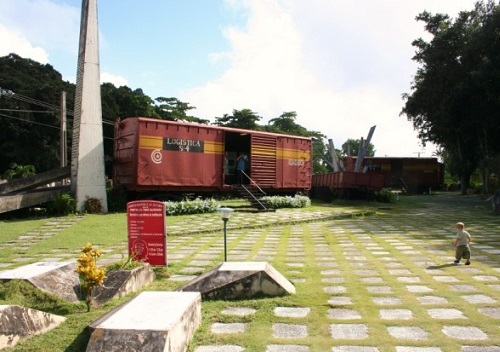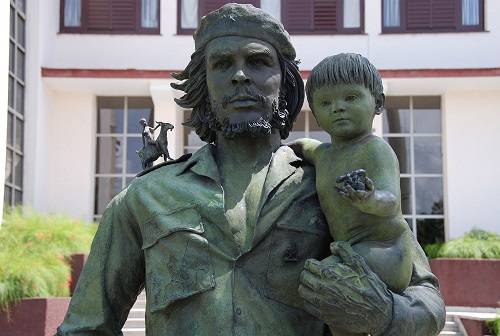|
~ Ernesto Che Guevara
~ Galéria
~ Oldal
~ Bejelentkezés
~ Vissza a Főoldalra
Ernesto Che Guevara, az argentin származású forradalmár, miniszter, gerillavezér és író, Buenos Aires-ben szerzett orvosi diplomát, majd a kubai forradalom során jelentős szerepet játszott a szigetország felszabadításában és újjáépítésében. A kubai gazdaság talpraállításáért dolgozott, küzdött az oktatás és az egészségügy fejlesztéséért, az írástudatlanság és a faji előítéletek felszámolásáért. Saját példájával népszerűsítette az önkéntes munkát. Kongóban és Bolíviában is harcolt - harminckilenc éves volt, amikor az amerikai-bolíviai csapatok csapdába ejtették és kivégezték.
| | |
|

| | |
|
|

The Che Guevara Mausoleum (Mausoleo Che Guevara) can be found in Santa Clara, Cuba. The building started in 1982 and it was finished in 1988. It was inaugurated on 28th December 1988 - on the anniversary of the Battle of Santa Clara.
The architects Jorge Cao Campos, Blanca Hernández and José Ramón Linares, and the sculptors, José de Lázaro Bencomo and José Delarra were working on it - with about 500,000 Santa Clara residents who gave more than 400,000 hours of volunteer work.
Che's almost seven-meter-tall bronze statue is surrounded by columns, adorned with sculptures and texts, describing a lot of aspects of his life like his years in the Sierra Maestra with Camilo Cienfuegos, his performing voluntary work or his speech at the United Nations. His farewell letter to Fidel Castro is inscribed full.
Interesting things:
- The square has an area of 17,556 square metres and its capacity is enough for a hundred thousand people.
- The gallery has an area of 2,000 square metres and its capacity is enough for nine hundred people.
- On each side fourteen palm trees stand - referring to the birthdate of Che Guevara - 14 of July 1928.
- On the murals there are 144 figures, including Che himself, Fidel Castro, Camilo Cienfuegos, Celia Sanchez, the members of the column Nr 4. and Bolivian guerrillas. There are such events shown like the campaign in Las Villas, the battle of Santa Clara, the occupation of the barracks Nr 31, the derailment of the armoured train, Che's doing some voluntary work and the Literacy campaign.
The memorial site also contains the remains of Che and twenty-nine of his combatants - all of them were killed in Bolivia. In the museum everything is dedicated to Che's life and the eternal flame for his memory burning brightly was lit by Fidel Castro.
Che Guevara was laid to rest with full military honors on 17th October 1997 after his remains were discovered and brought back to Cuba. Hundreds of thousands of people were watching the ceremony while schoolchildren sang Carlos Puebla's Hasta Siempre, then Fidel Castro made a moving speech and twenty-one cannon shots rocked the sky in Santa Clara and Havana, while air raid sirens were shouting across the island.
Che Guevara had his biggest victory in Santa Clara when his column took the city on 31st December 1958 - this victory made the dictator Batista leave the country forever.
[In another part of Santa Clara we can visit Tren Blindado - Che and his soldiers derailed Batista's military supply train there and today it is also a memorial place and museum. [See at the bottom of the module.]
With Che, six of his combatants were buried on the same day: the Cubans Carlos Coello (Tuma) (Rio Piraí on June 26, 1967); Alberto Fernandez Montes de Oca (Pacho) (Quebrada del Yuro on October 8, 1967); Orlando Pantoja Tamayo (Olo) (Quebrada del Yuro on October 8, 1967); René Martínez Tamayo (Arturo) (Quebrada del Yuro on October 8, 1967); the Peruvian Juan Pablo Navarro-Lévano Chang (El Chino) (La Higuera on October 9, 1967) and the Bolivian Simeon Cuba Sarabia (Willy) (La Higuera on October 9, 1967).
Between 1997 and 2000 twenty-three remains of other combatants were discovered and buried in the mausoleum.
On 29th December 1998:
The Argentine-German Haydée Tamara Bunke Bider (Tania) (Vado del Yeso on August 31, 1967); the Cuban Manuel Hernández Osorio (Miguel) (Quebrada de Batan on September 26, 1967); the Bolivians Mario Gutierrez Ardaya (Julio) (Quebrada de Batan on September 26, 1967); Roberto Peredo Leigue (Coco) (Quebrada de Batan on September 26, 1967); Aniceto Reinaga Cordillo (Aniceto) (Quebrada del Yuro on October 8, 1967); Francisco Huanca Flores (Pablito) (Los Cajones on October 12, 1967); the Peruvian Garvan Edilverto Lucio Hidalgo (Eustace) (Los Cajones on October 12, 1967); the Bolivian Jaime Arana Campero (Chapaco) (Los Cajones on October 12, 1967); the Cuban Octavio de la Concepcion Pedraja (Moro) (Los Cajones on October 12, 1967); and the Bolivian Julio César Méndez Korné (Nato) (Mataral on November 15, 1967).
On 8th October 1999:
The Bolivians Apolinar Aguirre Quispe (Polo) (Vado del Yeso on August 31, 1967); Freddy Maimura Hurtado (Ernesto) (Vado del Yeso on August 31, 1967); the Cubans Gustavo Manchin Hoed de Beche (Alejandro) (Vado del Yeso on August 31, 1967); Israel Reyes Sayas (Braulio) (Vado del Yeso on August 31, 1967); Juan Vitalio Acuña Nuñez (Joaquin) (Vado del Yeso on August 31, 1967); the Bolivians Moises Guevara Rodriguez (Moses) (Vado del Yeso on August 31, 1967); Walter Arencibia Ayala (Abel) (Vado del Yeso on August 31, 1967).
On 8th October 2000:
The Cubans Eliseo Reyes Rodriguez (Rolando) (El Meson on April 25, 1967); Antonio Sanchez Diaz (Marcos) (Peña Colorada on June 2, 1967); the Bolivians Serapio Aquino Tudela (Serafin) (Iquira on July 9, 1967); Condori Casildo Varga (Victor) (Rio Rosita on July 30, 1967); the Cuban Jose Maria Martinez Tamayo (Papi) (Rio Rosita on July 30, 1967) and the Peruvian Restituto José Cabrera Flores (El Negro) (Rio Palmarito on September 4, 1967).
[Che Guevara Memorial - Photo gallery]

In Santa Clara we can find other memories of Che.
Tren Blindado is the place where the Battle of Santa Clara was taken place and where Che's column defeated Batista's army. Che and his soldiers used a bulldozer to derail an armoured train that was carrying a huge load of provisions and ammunition for Batista’s army, and 373 armed soldiers. The rebels seized the weapons and the ammunition - twelve hours later Batista left Cuba forever.
Today at Tren Blindado an open-air museum can be visited featuring the armoured train cars, a replica of the bulldozer, photos, and replicas of the weapons.

In Santa Clara we can also find another beautiful statue of Che Guevara called El Che y los niños. Here we can see him with a little boy on his left arm while he seems to be walking forward.
|
|
|
|
~ Ernesto Che Guevara
~ Gallery
~ Site
~ Log in
~ Back to the Main page
Ernesto Che Guevara, the Argentine-born revolutionary, minister, guerrilla leader and writer, received his medical degree in Buenos Aires, then played an essential part in the Cuban Revolution in liberating and rebuilding the country. He did his best to set up the Cuban economy, fought for the improvement of the education and the health system, the elimination of illiteracy and racial prejudice. He promoted voluntary work by his own example. He fought in the Congo and in Bolivia - he was thirty-nine years old, when he was trapped and executed by the joint American-Bolivian forces.
| | |
|
|

